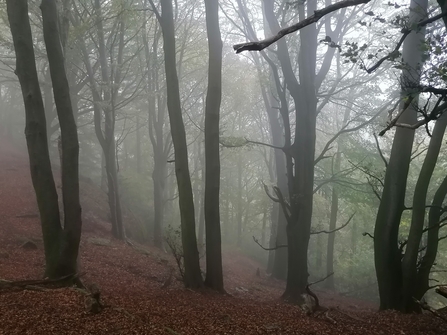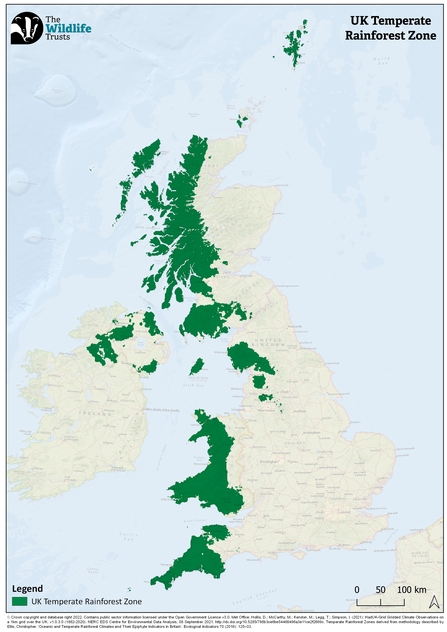
Temperate rainforests, with their ancient trees, are cool, damp places with huge biodiversity - Staveley Woodlands Nature Reserve © Danni Chalmers
Gifting membership? Order by Wednesday 17 December in time for Christmas.

Temperate rainforests, with their ancient trees, are cool, damp places with huge biodiversity - Staveley Woodlands Nature Reserve © Danni Chalmers
The Wildlife Trusts are embarking on an ambitious new project to restore rainforests in the UK thanks to £38 million of funding from Aviva.
It is part of a wider programme of nature-based projects funded by Aviva to remove carbon from the atmosphere. It will improve biodiversity and climate resilience by restoring wild places including UK temperate rainforests. UK rainforests have been largely destroyed over many hundreds of years for timber, farming, transport networks and development. Now they cover less than 1% of the UK in areas such as western Scotland, the Lake District and western Wales.
Creating and connecting wilder landscapes is fundamental for nature’s recovery, stopping climate change and adapting to its impacts. This includes achieving UK net-zero targets, reducing the threat from extreme heat, flood and drought, and protecting at least 30% of land and sea for nature by 2030.
Craig Bennett, chief executive of The Wildlife Trusts, says:
“We’re looking forward to working with communities to bring back rainforests along the UK’s Atlantic coast – these woods are magical and much loved by those who visit and live near them.
“The task of restoring land to help nature recover and store carbon has never been more urgent. Nature – wild habitats and the species that depend on them – is in fast decline and we’re in a climate crisis. These twin emergencies are interlinked and threaten communities, water supplies and the future of farming – which is why we’re so pleased that, with Aviva’s support, we’ll be substantially increasing our efforts to address these crises.
“We have very strict criteria for what we consider to be a very high integrity carbon credit scheme for the residual emissions still left after strenuous efforts to reduce them at source. Aviva’s approach meets our high standards. We’re excited that we’ll now be able to work with many more communities to help nature fight back, improve climate resilience and enhance the lives of all those involved through these projects.
“We believe that there needs to be a huge increase in nature-based solutions to climate change – but it’s critical that these solutions are not used as an excuse to carry on with a polluting ‘business as usual’ model which fails to reduce emissions at source. Too often, businesses try to ‘put the genie back into the bottle’ – but Aviva is taking a more far-sighted approach. It is investing in restoring nature to store carbon 20 years before the carbon associated with Aviva’s potential future investments goes into the atmosphere. This is to be applauded.”
Amanda Blanc, Aviva Group Chief Executive Officer, said:
“The fact that Britain’s native rainforests will take carbon out of the Earth’s atmosphere is reason enough to restore them. But on top of that, they’re incredibly rare and beautiful. This vital work we are undertaking with The Wildlife Trusts will mean people can experience this rich natural habitat. Communities being able to access these sites will improve wellbeing and show how biodiversity fights and reduces the impacts of climate change. Aviva is proud to help reestablish temperate rainforests in the UK as part of our efforts to be a Net Zero company by 2040.”
The UK’s rainforests are temperate rainforests, which means they grow in areas that have high rainfall and humidity, and a low annual variation in temperature. They are also known as Atlantic woodland or Celtic rainforest.
UK rainforests are made up of trees including sessile oak, birch, rowan, holly, alder, willow and hazel. They are home to stoats, red squirrels, and pine marten, and threatened bird species like wood warblers, redstarts, and pied flycatchers. Wet conditions support a luxuriant abundance of mosses, liverworts, lichens, and ferns – many of which grow on the trees or cover boulders, crags and ravines. The dampness is ideal for masses of fungi, including globally rare species.
As trees grow, they absorb carbon from the atmosphere which is stored in the soil, roots, trunks, and branches of the tree itself. The epiphytes – the lichens, mosses and ferns covering the trees – also carry out this function, and so UK rainforests have huge potential for storing carbon.
To achieve the UK’s net-zero ambition, it is estimated that woodland cover needs to increase to at least 17% across the UK by 2050 (it is currently around 13%). Research, surveying and working with communities are the first steps to establishing which areas of land are suitable for rainforest regeneration.
The Wildlife Trusts will ensure that these restored rainforests are as resilient as possible to increased heat, drought and fire as the climate changes. As well as being established in the wettest parts of the UK, we are choosing tree species with reduced risk from wildfire and will be monitoring our projects carefully over time to measure their biodiversity and adaptation benefits. Improving the size and connectivity of our rainforests will maximise their resilience to changing conditions.
Aviva funding
Please see Aviva’s press release ‘Aviva helps restore rare native British rainforests’ here. It states:
“The restored temperate rainforest will remove an estimated 800,000 tonnes of carbon dioxide from the atmosphere over the next 100 years. This is equivalent to the emissions created by driving over 2.46 billion miles or driving 24,000 family cars for 100,000 miles.
“The carbon removal will begin from 2024 and will be at its fastest around 2060 when the forests are expected to be removing about 24,000 tonnes CO2 each year. The carbon removal will continue at a slower rate well beyond 2130. The whole woodland creation programme is expected to bring about a net reduction in atmospheric carbon levels from 2036 onwards. It is expected that by 2040, when Aviva plans to be a Net Zero company, the projects will already have removed more than 34,000 tonnes of emissions from the atmosphere.
“The carbon removal should deliver significant biodiversity and climate change adaptation benefits by creating habitat that can support flora including mosses, lichen, ferns and to a host of unusual plants and wildlife such as wood warblers, bats, pine martens and red squirrels. The increase in woodland should also help to moderate water flows and improve shading in the hotter, drier conditions expected with climate change.”
IUCN Nature-based solutions standard
A critical component of this scheme for The Wildlife Trusts is that Aviva are investing in a range of benefits from the restoration of UK rainforest; including but not limited to carbon. The biodiversity, adaptation and community benefits of these projects are as important and are a central part of the investment which Aviva is making. The Wildlife Trusts helped to pilot the IUCN global standard on nature-based solutions, which aims to ensure that nature-based solutions benefit biodiversity, health and well-being, and climate resilience. These aspects of the project are core to the aims of both Aviva and The Wildlife Trusts and we will be following the standard as part of this project.
See our Rainforests of the UK – a briefing by The Wildlife Trusts.

UK Temperate Rainforest Zone
Map © Crown copyright and database right 2022. Contains public sector information licensed under the Open Government Licence v3.0. Met Office; Hollis, D.; McCarthy, M.; Kendon, M.; Legg, T.; Simpson, I. (2021): HadUK-Grid Gridded Climate Observations on a 1km grid over the UK, v1.0.3.0 (1862-2020). NERC EDS Centre for Environmental Data Analysis, 08 September 2021. http://dx.doi.org/10.5285/786b3ce6be54468496a3e11ce2f2669c. Temperate Rainforest Zones derived from methodology described by Ellis, Christopher. ‘Oceanic and Temperate Rainforest Climates and Their Epiphyte Indicators in Britain’. Ecological Indicators 70 (2016): 125–33.